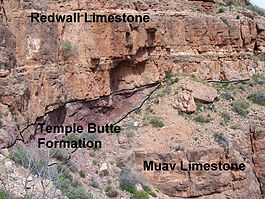| Muav Limestone | |
|---|---|
| Stratigraphic range: Middle Cambrian [1] | |
 representative sequence of Redwall Limestone, Temple Butte Formation, and Muav Limestone, in Grand Canyon | |
| Type | Geological formation |
| Unit of | Tonto Group[2] |
| Underlies | either the Frenchman Mountain Dolostone (Cambrian) or Redwall Limestone (Mississippian). Locally underlies Temple Butte Formation (Devonian) that fills narrow paleovalleys cut into the Muav Limestone. |
| Overlies | Bright Angel Shale |
| Thickness | 250 m (820 ft), at maximum |
| Lithology | |
| Primary | limestone and dolomite |
| Other | shale and intraformational conglomerate. |
| Location | |
| Region | Northern Arizona (Grand Canyon), central Arizona, southeast California, southern Nevada, and southeast Utah |
| Country | United States of America |
| Type section | |
| Named for | Muav Canyon, north side of Colorado River[3] |
| Named by | Noble (1914)[3] |
The Muav Limestone is a Cambrian geologic formation within the 5-member Tonto Group. It is a thin-bedded, gray, medium to fine-grained, mottled dolomite; coarse- to medium-grained, grayish-white, sandy dolomite and grayish-white, mottled, fine-grained limestone. It also contains beds of shale and intraformational conglomerate. The beds of the Muav Limestone are either structureless or exhibit horizontally laminations and cross-stratification. The Muav Limestone forms cliffs or small ledges that weather a dark gray or rusty-orange color. These cliffs or small ledges directly overlie the sloping surfaces of the Bright Angel Shale. The thickness of this formation decreases eastward from 76 m (249 ft) in the western Grand Canyon to 14 m (46 ft) in the eastern Grand Canyon. To the west in southern Nevada, its thickness increases to 250 m (820 ft) in the Frenchman Mountain region.[2][4]
Beyond the Grand Canyon area, the Muav Limestone is recognized in southern Utah, southern Nevada and southern California.[5] In parts of California, it is known and mapped as the Muav Marble.[6]
- ^ Karlstrom, K.E., Mohr, M.T., Schmitz, M.D., Sundberg, F.A., Rowland, S.M., Blakey, R., Foster, J.R., Crossey, L.J., Dehler, C.M. and Hagadorn, J.W., 2020. Redefining the Tonto Group of Grand Canyon and recalibrating the Cambrian time scale. Geology, 48(5), pp. 425–430.
- ^ a b Connors, T.B., Tweet, J.S., and Santucci, V.L., 2020. Stratigraphy of Grand Canyon National Park. In: Santucci, V.L., Tweet, J.S., ed., pp. 54–74, Grand Canyon National Park: Centennial Paleontological Resource Inventory (Non-sensitive Version). Natural Resource Report NPS/GRCA/NRR—2020/2103. National Park Service, Fort Collins, Colorado, 603 pp.
- ^ a b Noble, L.F., 1914. The Shinumo quadrangle, Grand Canyon district, Arizona. U.S. Geological Survey Bulletin. 549. doi:10.3133/B549. ISSN 0083-1093.
- ^ Middleton, L.T. and Elliott, D.K., 2003. Tonto Group, in Beus, S. S., and Morales, M., eds. Grand Canyon geology Museum of Northern Arizona Press, Flagstaff, Arizona. pp. 90–106.
- ^ Wood, W., 1966. Facies Changes in the Cambrian Muav Limestone, Arizona. Geological Society of America Bulletin, 77(11), pp.1235-1246.
- ^ Hamilton, W.B., 1987. Mesozoic geology and tectonics of the Big Maria Mountains region, southeastern California. Arizona Geological Society Digest, v. 18, pp. 33-45.